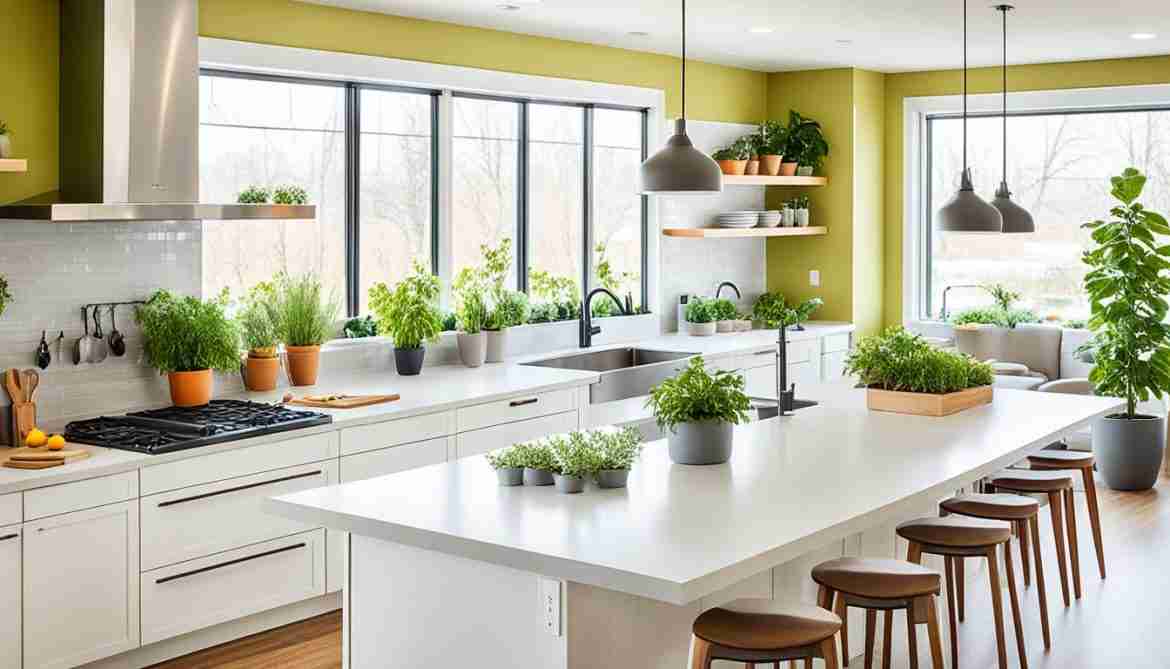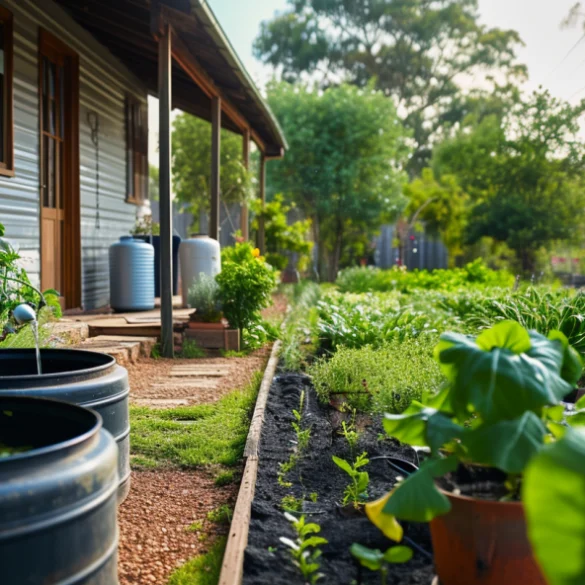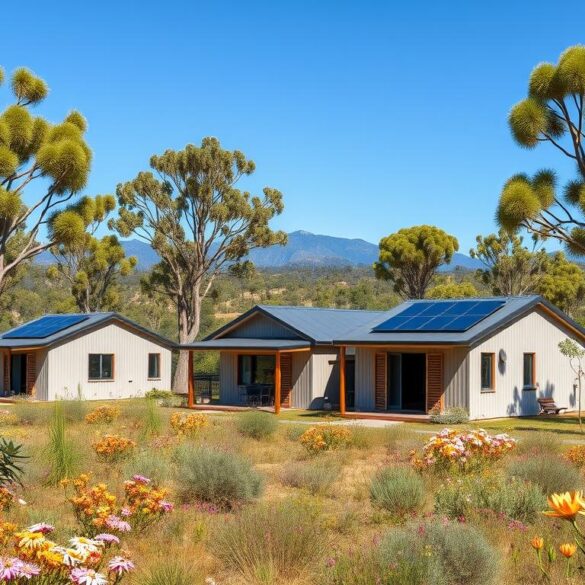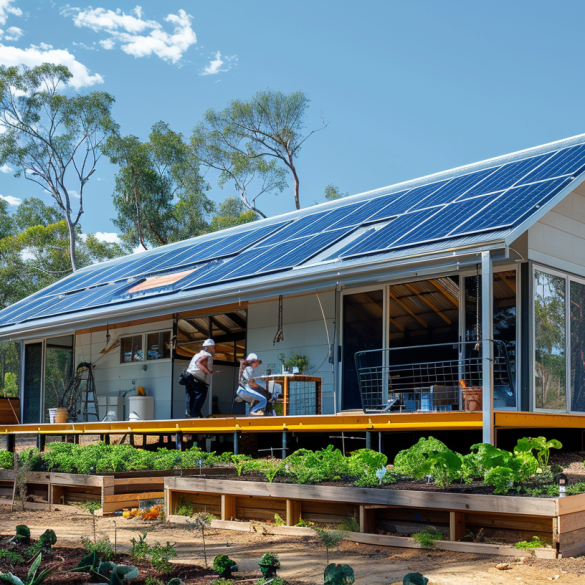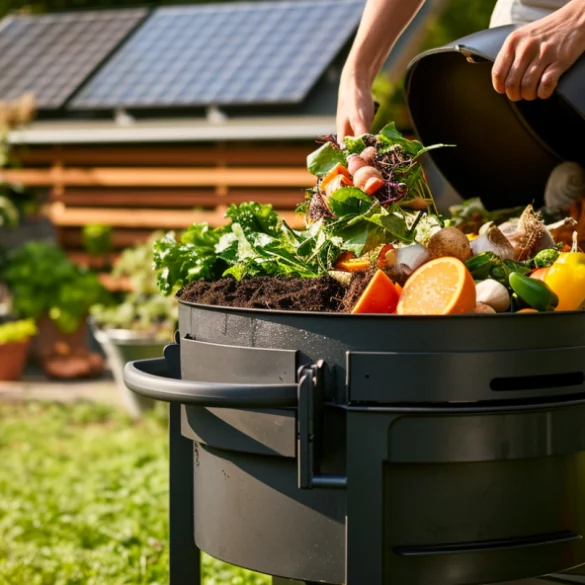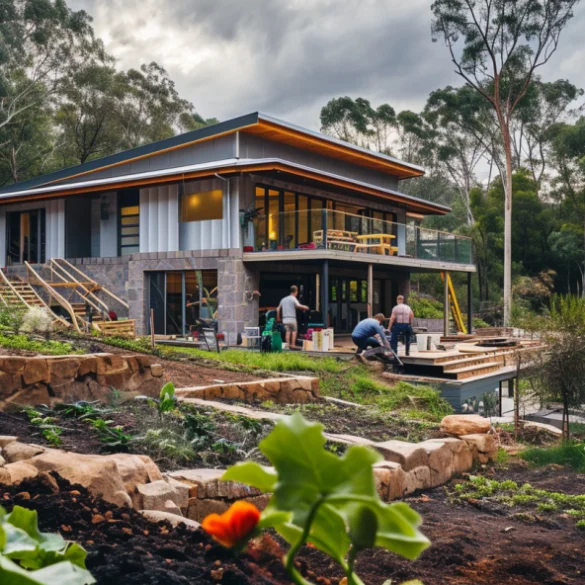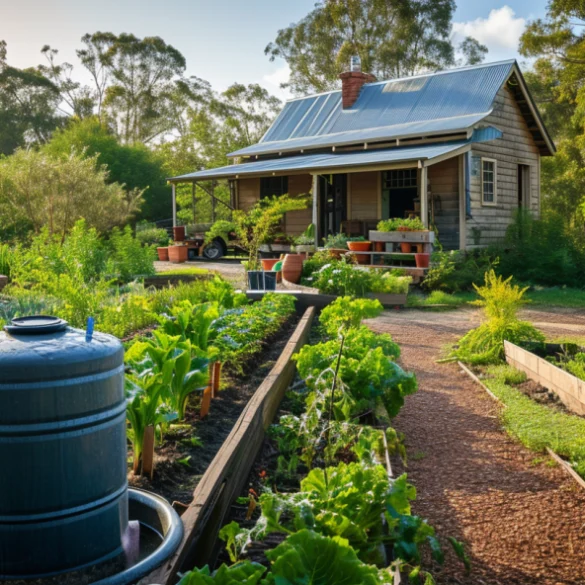Imagine if your kitchen could change with you, meeting new needs while staying stylish and eco-friendly.
The interest in kitchens that work well for seniors and those with disabilities is growing. Sustainable Home Magazine tells us almost twenty percent of Australians have long-term disabilities1. This means there is a big need for homes that everyone can use. These changes don’t just help people live on their own longer. They also help those who take care of them and bring neighbors closer together.
Key Takeaways
- Accessible kitchen renovations are increasingly essential for senior-friendly and disability-friendly kitchen remodeling.
- Sustainable Home Magazine emphasizes the importance of inclusive designs for aging Australians with long-term disabilities1.
- Modifying homes to be adaptable extends their serviceable lifespan, yielding financial and environmental benefits.
- Sustainable upgrades enhance property value and ensure lifelong comfort for occupants.
- Collaborative housing initiatives can strengthen economic resilience and community ties.
Introduction to Sustainable Kitchen Design
Sustainable kitchen design means making kitchens that are good for the earth. It also helps seniors and disabled people. This way, everyone can live safely and independently at home.
Understanding Sustainability in Kitchen Remodeling
People are focusing more on making kitchen changes that help the planet. They are using appliances that don’t waste energy and water. They choose materials that are reused or eco-friendly. For cleaning, people use recycled or glass bottles and eco-friendly bin bags. This cuts down on plastic use and helps the environment2. Also, people pick kitchen items that last long and are made in a way that doesn’t harm forests. These items have special certifications, showing they were made with care for the earth2.
The Importance of Accessibility in Kitchen Design
It’s important that kitchens are easy to use for everyone, especially for those with walking difficulties. Equal Access and similar groups push for kitchens that meet everyone’s needs. They make sure kitchens are easy and safe for people with different abilities to use1. This is part of a bigger plan called “Build for Life,” which wants all homes to have inclusive kitchens. These kitchens are designed for people to live comfortably at any age or stage1.
Demographic Considerations: Seniors and Disabled Individuals
Many people in Australia are getting older, and about one-fifth of them have a disability1. This shows the growing need for kitchens that suit seniors and those with special needs. Research has found that well-planned kitchens can really help older people stay healthy and active3. So, it’s not only about making life easier. It’s about making sure everyone can enjoy their home fully.
Essential Features of an Accessible Kitchen
An accessible kitchen helps seniors and people with disabilities be more independent. It removes barriers like steps, has countertops that can be changed in height, and uses floors that are safe to walk on. These changes make the kitchen safe and easy to move around in for everyone.
Stepless Entries and Wider Doorways
A kitchen with no steps at the door stops people from tripping. It’s important for those who have trouble walking. Doors that are at least 1 meter wide let wheelchairs and walkers move freely4. Making these changes helps keep the kitchen safe and useful.
Adjustable Countertops and Cabinets
Countertops and cabinets that can move up or down help everyone. They make it easier for both those who can stand and those who sit to use the kitchen. This way, the kitchen is comfy and cuts down on any strain54.
Non-Slip Flooring and Safe Surfaces
Having floors that won’t make you slip is key. They keep people from falling, especially if they don’t move so easily4. Adding bright lights helps too. They make it easier to see and work, especially for older folks who might not see as well6. These steps can really make the kitchen safer for everyone.
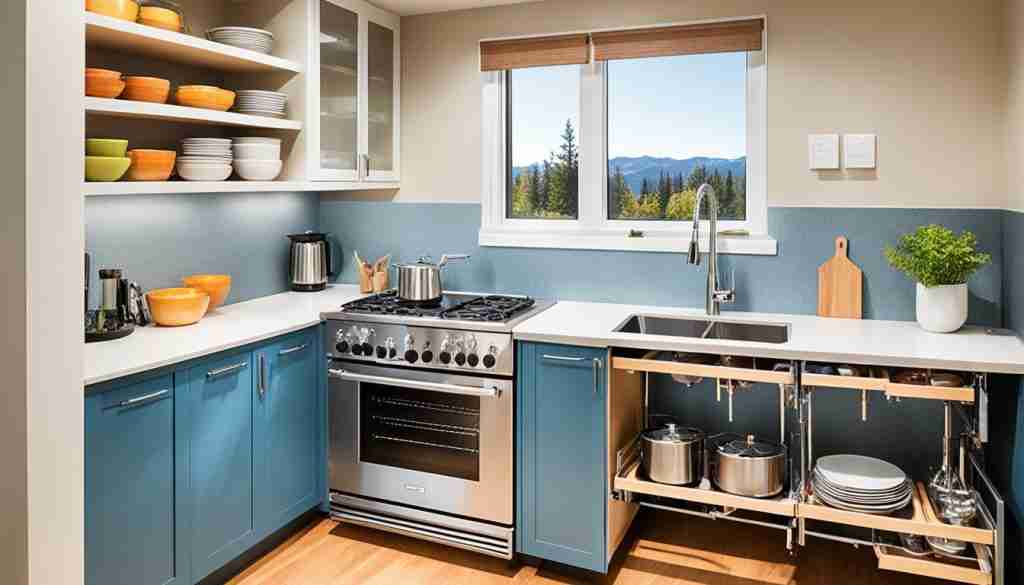
Eco-Friendly Modifications for Aging-in-Place
Living well while aging at home can be made better through green kitchen changes. These updates help save the earth and make life easier for older folks. They improve both our environment and the comfort of those aging in their own homes.
Energy-Efficient Appliances
Switching to energy-saving kitchen gadgets is key for those wanting to help the planet. These devices use less power, which cuts costs and benefits the environment. Seniors at home a lot can see big savings by choosing appliances like efficient dishwashers or fridges.
Water-Saving Fixtures
Updating to low-flow taps and toilets that use less water is a great idea. It’s not only good for the planet but also for keeping bills low. With these fixtures, homes save water without losing convenience. Some have levers that are easy for seniors to use.
Recycled and Eco-Friendly Materials
Using materials like recycled glass or bamboo in kitchens is both eco-friendly and healthy. It helps reduce harmful chemicals, making living spaces safer and more comfortable. Kitchens made this way are not just good for the earth but for the well-being of the people living in them, especially seniors.
Also, designing kitchens with senior safety and usability in mind is a positive trend. This move to make kitchens more green and senior-friendly is increasing. Studies show many home updates are focused on making kitchens better for older people living at home7.
More and more seniors are picking eco-friendly options for their homes. They’re looking at the big picture, including their future needs and the environment. Resources on aging-in-place, like those for home modifications, offer great tips for these green changes.
Kitchen Upgrades for Seniors and Disabled
Creating a kitchen for seniors and disabled folks needs careful planning. You can improve safety, access, and how well things work. This makes cooking and using the kitchen easier for them.
Lever-Style Faucets and Easy-to-Use Fixtures
Lever-style faucets are big helpers in a handicap-accessible kitchen. They’re great for people with weak hands or who find it hard to grip. Using these faucets means they can do it by themselves more easily. Long, smooth-handled fixtures are good too for easier use8. Accessible sinks and lever taps are also smart choices. They make the kitchen safer and more functional9. For seniors, these changes mean they can keep their independence in daily life tasks.
Pull-Out Shelves and Lazy Susans
Adding pull-out shelves in lower cabinets is important for a kitchen that’s easy to move around in8. This makes items easier to get to without having to bend or reach too far. Putting in Lazy Susans in cabinets is another good move. It can cost from $100 to $300 per cabinet10. These changes also fit with the NDIS aim to make kitchens more user-friendly. This helps seniors and those with disabilities stay independent9.
These upgrades don’t just make the kitchen safer. They also make it more welcoming and useful for everyone.
Assistive Technology for Enhanced Accessibility
New technology has made kitchens more accessible for seniors and those with disabilities. Lifts and stairlifts help people move around their homes easier11. This technology is also cost-effective for older adults12.
Smart Home Devices for the Kitchen
Adaptive cutting boards and easy-to-use appliances are becoming popular for easier cooking13. Last year, the sale of smart kitchen gadgets went up by 40%, showing how helpful they are13. They make the kitchen a safer and more efficient place.
Voice-Controlled Appliances
Voice-activated devices make cooking hands-free for those with trouble moving. Many older people fear the kitchen because of this13. These smart appliances boost safety and independence12.
Automated Lighting and Blinds
Smart lights and blinds improve safety and make life easier by reducing risky tasks. Better lighting can prevent falls and keep seniors safe11. More and more people are choosing these smart options to create a secure home12.
Case Studies of Successful Kitchen Renovations
In recent times, changing kitchens for the elderly is really important. It ensures their safety and makes things easier for them. Real stories from Australia show how this is done. They prove that making a kitchen easier to use is more than just making it look good.
Real-Life Examples from Australian Homes
A family in Brisbane chose adjustable countertops and cabinets. This helped seniors use the kitchen without trouble. They could cook comfortably, which made them feel more independent and happy.
In Melbourne, sliding doors were added to a kitchen. This change made the kitchen safer for both seniors and kids. It also fit with the modern, sleek style that is popular in Australia right now14.
Handle-free drawers and cupboards made another kitchen in Sydney look stylish. At the same time, they met the needs of seniors. This design style is becoming more common, with a focus on keeping things simple and easy to use14.
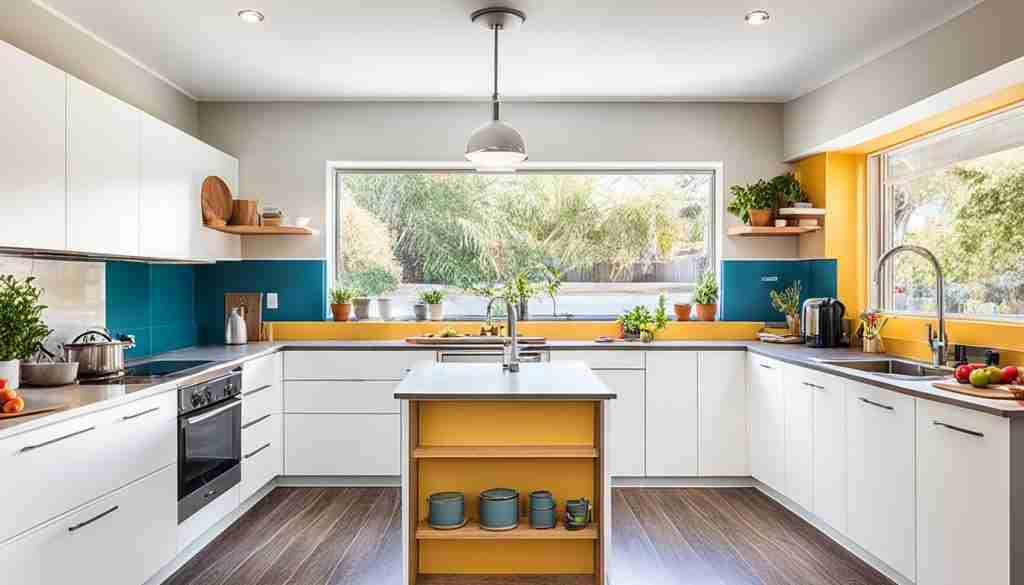
Feedback and Experiences from Users
People loved the changes made to their kitchens. A resident in Sydney said the updates made cooking much better. And a family in Melbourne said their kitchen was much safer and easier to use. Their stories show the real benefit of these changes for the elderly.
There was also a study that showed home updates can reduce falls and help seniors live better from 201215. This research highlighted how important it is to get advice from experts when you’re making changes.
In Denmark, feedback tells us that many seniors face nutrition problems. This proves we need to design kitchens carefully, to meet special food and safety needs16. When we do this, seniors can eat better, which is key to their health16.
All this information helps families and individuals who want to update their kitchens. The aim is to make a kitchen that’s safe, easy to use, and looks good. This way, the elderly can keep their independence and enjoy a modern kitchen.
Expert Tips for Planning and Executing Your Kitchen Remodel
To redo your kitchen well, you need a smart plan and wise choices. Getting advice from the pros is key to a successful accessible kitchen redo. This ensures the changes fit the users’ needs and follow important guidelines.
Consulting with Accessibility Professionals
Experts in making spaces accessible help a lot. They know how to plan so kitchens work for seniors and those with disabilities. They make sure changes like easy entries and wider doors are safe and help move around better.
Knowing the size of your kitchen is step one to its redesign17. With the pros’ advice, you’ll create a kitchen that’s easy to use and meets safety standards.
Budgeting for Sustainable and Inclusive Upgrades
Good budgeting is vital for a kitchen redo to go well. Experts say the budget is key to any kitchen makeover to plan your spending right17. Think about ways to pay, like loans, or help from loved ones17.
You can save money with smart choices, like using eco-friendly materials. This way, you get a great kitchen without spending too much17.
Having extra money for surprises is smart. You could need it for extra bills or hidden costs. Also, be ready for the project to take longer than expected due to various reasons17.
Knowing about green design helps too. It’s about adding eco-friendly stuff to your kitchen. This will make your kitchen better for the earth and last longer.
Financial Assistance for Conversions
Getting help for kitchen changes can cut costs for the elderly and those with disabilities. Many programs give money for senior-friendly kitchens or to make kitchens easier to use for people with disabilities.
Where to Access Government Assistance
In Australia, lots of places can help with government aid for updating kitchens. The Victorian Aids and Equipment Program (VA&EP) gives out funds for equipment and changes. This helps people live more safely and on their own18. Also, different states’ Medicaid programs help with making homes easier to live in, especially for seniors19. Veterans might get grants like SAH and HISA to modify their homes for their needs19. The Department of Housing and Urban Development and the U.S. Department of Agriculture have loans and grants for making homes better19.
If you can’t use the National Disability Insurance Scheme (NDIS), the VA&EP could still be an option. They look at your age, where you live, and how much help you need18. Also, the USDA helps homeowners with low incomes make their homes safer20.
Eligibility for Government Assistance for Kitchen Conversions
For this help, you need to meet different program rules. Medicare Advantage plans now help by covering costs for home changes starting in 202019. For the VA&EP, you must have an Assistive Technology check, and meet certain rules, like filling out forms and getting a check-up18.
Rebuilding Together changes homes for those who are low-income, have disabilities, are seniors, or are in the military20. Also, Area Agencies on Aging help with changing homes so seniors and people with disabilities can live safer and happier20.
Learning about and meeting the rules can get you a lot of help for fixing up your kitchen. These programs make sure kitchens are easy to use and safe for everyone.
Conclusion
In conclusion, upgrading kitchens for seniors and the disabled is crucial. It creates safe, accessible spaces. These areas make daily life easier and improve living quality. A wheelchair-accessible kitchen remodel makes the kitchen safer and gives people more independence.
This kitchen upgrade pairs universal design with sustainability. For example, using energy-efficient appliances and non-slip flooring. This combo makes the kitchen both useful and good for the planet. Fall prevention programs have shown to boost older adults’ lives by 499% to 506%21. They stop falls and make daily activities easier21.
Changing kitchen design, like adding adjustable countertops, helps older adults live better. Their daily function can improve by 284% to 291%21. These changes make using the kitchen simpler and boost well-being. Making kitchens suit the specific needs of aging and disabled people helps everyone live better. The CAPABLE trial shows a full approach can cut down on disability by 102% to 112%21.
Adapting homes for the elderly and disabled leads to better health outcomes. It also saves money in health and social care21. With good planning and advice, Australian homes can become perfect for all. Choosing universal design kitchen solutions and being sustainable keeps the kitchen comfy and useful for everyone.

